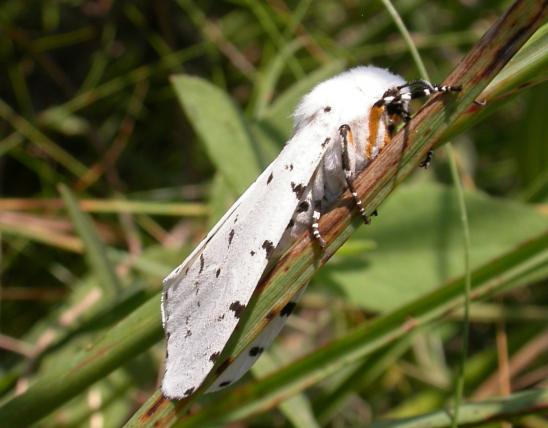
The giant leopard moth is a beautiful large white moth that is easy to identify. The forewings have numerous black spots, many with hollow (white) centers. Some of the dark markings are iridescent blue in the light. The hindwing is shaded with black along the inner edge and has spots near the outer tip. As the moth ages, the outer parts of the wings may lose scales and begin to look translucent. The abdomen — usually covered by the wings when the moth is at rest — has striking lines of iridescent blue, orange, and black markings.
Mature caterpillars are black with red sections between the segments. Tufts of stiff black bristles emerge from brownish tubercles on each segment. The spiracles (small rounded openings on the side of each segment) are orange or red. This is the largest woolly bear in Missouri, reaching 3 inches long.
Note that some types of caterpillars have stinging hairs, and some people are sensitive to even the types that don’t sting. If you are unsure about an identification, or about your sensitivity to possible skin-irritating toxins, you should not touch any fuzzy caterpillars with bare skin.
Learn more about this and other tiger and lichen moths (subfamily Arctiinae) on their group page.
Similar species: The giant leopard moth is very distinctive and easy to identify.
Wingspan: 2¼–3½ inches.
Statewide.
Habitat and Conservation
When most people see giant leopard moths, they are usually seeing males that are attracted to lights at night.
In early spring, people sometimes discover the fully grown, hibernating caterpillars by peeling back the bark from dead trees and logs.
Food
Caterpillars eat the foliage of a wide variety of plants, including maples, dandelions, sunflowers, cabbages , cherries, willows, and violets. Caterpillars are most commonly found on low-growing plants, occasionally on trees and shrubs. In southern states, the caterpillars also eat orange and banana leaves.
Status
Seldom common.
Life Cycle
Adults fly early May–September, with multiple broods. Females are larger than males.
Human Connections
Moths have a reputation for being drab, but the giant leopard moth is gorgeous.
Ecosystem Connections
Most moths are a favorite food of birds, most of which hunt moth caterpillars by day, and bats, which hunt adult moths at night.

























